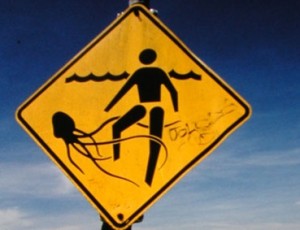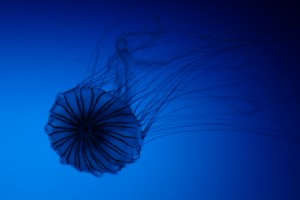It’s spring break the oceans over.

Australia’s beaches regularly host many types of toxic gelatinous animals, including the notorious Portuguese Man-of-War and Chironex fleckeri, a type of box jellyfish that is the world’s most venomous animal; a Chironex can kill a person in under three minutes.
In addition, some species of potentially deadly box jellyfish known as Irukandji jellyfish are currently increasing in number in Australian waters, possibly because of climate change. These peanut-sized jellyfish are small enough to slip through nets that protect Australia’s beaches from their larger Chironex cousins.
–The National Science Foundation
The National Science Foundation has published an extensive report on the Dead Zone/jellyfish connections, but I thought I’d quote the article’s description of the upsides of jellyfish:
ECOLOGICAL ROLES OF JELLYFISH
Plying the world’s oceans for over 500 million years, gelatinous creatures have influenced marine communities almost as long as marine communities have existed.
As prey, gelatinous creatures are eaten by seabirds, pink salmon, sun fish, turtles and other gelatinous creatures. (Animals that eat jellyfish are not impacted by their stings.) As predators, gelatinous creatures eat fish eggs and larvae, invertebrates, small, floating creatures called zooplankton and other gelatinous creatures.
Scientists are continuing to identify new ecological services provided by jellyfish. For example, recent studies show that the tentacles dangling from the Bering Sea’s large jellyfish provide hiding places for young pollock that are pursued by other predators but have grown too big for the jellyfish to eat.
…This last upside, while über poetic (Jellyfish-as-beaded-curtain; Quick! let’s duck out of harm’s way and hide in this undulating petticoat) does make me wonder if the upsides are outweighed by an anvil-load of problems.


